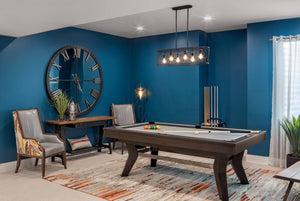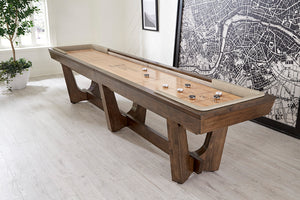Pool Cue Buyers Guide Part 1
When you are ready to purchase your first two piece pool cue the options can be overwhelming. Decent quality cues start around $50 and can go as high as $3,000 for production cues. One off custom cues and collectables can be even more costly. This guide is a good place to start before buying your first cue, or if you have been out of the pool cue market for a while and want to know what is new. Either way, the best advice we can give on picking a pool cue is to demo one before buying!
What To Look For
Here are a couple of helpful tips for the novice pool cue buyer: You don't have to spend hundreds of dollars to get a good quality cue. A perfectly good cue that can be found for under $100. Certainly budgetary restrictions are an issue for everyone, so don't break the bank looking for the right cue. Sporting Goods stores aren't going to carry quality cues, so here's where to look instead:
- Your local billiards shop or the Web
As a novice pool cue buyer, you're going to need something durable, so watch out for cues that do not carry a warranty against warpage. It has become common in the last few years for cues as inexpensive as $39 to carry some kind of warranty. We recommend major manufacturers like McDermott, Cuetec, Lucasi, Players and Action, known for making cues that play well but also are backed by a warranty.
Here are some other considerations:
- The intricacy and aesthetic appeal of inlays-- while they may look sharp, finely crafted inlays can raise the price of a cue by thousands of dollars.
- You probably don’t want to try out a custom cue unless you’re a very serious player or already know a lot about cues. Custom cues start around $200 and are a great investment, but typically you will need to have played with a nice two piece cue previously to appreciate the differences. Even higher end anufacturers like McDermott make plenty of excellent, playable cues good for the novice pool cue buyer.
- If you’re a female player looking for a good cue, try the Flirt Series from Players or Athena, a manufacturer specifically designing cues for women. They tend to be a little shorter, offer extension butts, or just have a more female oriented design.
The Stuff Cues Are Made Of
Consider the materials a cue is made out of:
- The harder the materials used, the more power your shot will have.
- Softer materials provide better control, a need for many players.
- The two primary types of material used to construct cues are fiberglass/graphite and wood. Serious players opt for wood, but fiberglass/graphite is resistant to warping and some other maintenance issues. New hybrid "technology" cues combine wood, graphite, carbon fiber, and other materials to create cues that combine more power and control than ever before.
- Cues weigh anywhere from 18-21 oz. for standard designs. Many leage organizations will not allow cues outside of thes range for tournament play. It is common to see 25oz, even 27oz "heavy hitter" break cues, but they might not be legal in your leage.
- What weight you use isn’t really determined on physical strength, but rather on your preference for a heavier or lighter cue. Among professional players, the trend is moving toward use of lighter cues. Most good players will use a cue between 19 and 20oz to shoot.
- Some cues have removable weight bolts, as many players favor breaking with a heavier cue. Most players use a separate cue for breaking as the tip will get worn out on your shootin cue from the impact of the break shot
Pool cues are usually 57-58 inches. The longer, more tapered sticks facilitate more spin and ball control. Also, if you have longer arms, a longer cue is a recommended step. Many nicer cues and aftermarket shafts feature thin diameter, all the way down to 11mm. Standard cues feature 13mm shafts, while some new "fat shaft" options are available with 14mm diameter shafts.
The Parts That Matter
Some parts of the cue are more important to the shot than others. The cue is broken into two parts: The butt, and the shaft. The butt is the heavier, bottom half of the cue, and the shaft is the top half, ending with the tip. One part many people consider essential to the shot is the joint, usually a metal screw that connects the butt to the shaft of a cue. Some points on the joint:
- A joint is where a shot’s “feel” is determined. Using other materials than metal—such as ivory, plastic or wood—can change the feel of the shot. McDermott cues are famous for the "feel" that comes from thier metal pin going directly into the wood of the shaft.
- Longer, wider joints generally are longer lasting but tend to take away from "feel". They are best suited for break or jump cues.
Consider the wrap, or handle, of the cue as well. If you perspire a lot, a leather wrap might be the best option to absorb that moisture. Wraps are also made of nylon, irish linen, or wood with a high-gloss finish. New high-tech rubber grips are also becoming more common, often taken from technology in the golf industry. The tip, or end of the shaft where one strikes the ball, is also critical. Generally made of leather, a softer tip is going to provide better control. There are a huge range of aftermarket tips available so you are best off talking to a local pro shop or billiards specialty retailer who can install better tips on your cue. You’ll also want to consider purchasing a cue case to make sure your stick is protected when you travel with it.
The Big Picture
The pool cue is a great investment for even casual players because you will have a hard time improving without consistancy. Using the same cue every time will allow you to work on things like stroke technique, english, and concentration without having to adjust to a new stick every time you play. Keeping your cue tip conditioned properly, having the right weight, balance, and taper, all allow you to take your game to another level. Regardless of your budget, a nice two piece cue will last for years and more than pay for itself in the confidence it brings your game. Thanks to bourderbilliards.com for some of the content of this article.




Comments
Leave a comment